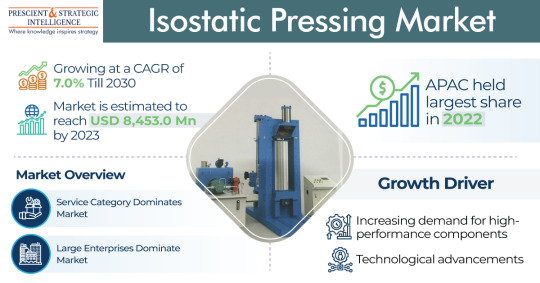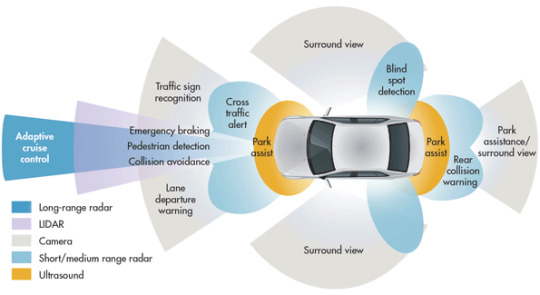#advanced forming technology
Text
Shaping the Future: Insights into the Isostatic Pressing Market
The global isostatic pressing market is projected to be USD 13,568.1 million by 2030 growing at a CAGR of 7.0% during the forecast period. sectors including energy, aerospace, medical devices, automotive, and manufacturing regularly use isostatic pressing. In this regard, the requirement for such technology is significantly impacted by the growing requirement for contemporary materials and…

View On WordPress
#advanced forming technology#advanced materials#aerospace industry#automotive components#ceramic components#engineering ceramics#high-pressure manufacturing#industrial manufacturing#industry trends#isostatic pressing#isostatic pressing applications#isostatic pressing process#manufacturing efficiency#market growth#material compaction#metal parts production#powdered metals#precision engineering
0 notes
Text
Halves company
Danny had a big problem: since a couple of days ago he had discovered that he didn't look good in pictures. He wasn't a vampire so he was actually in them but his eyes always looked bright green, and the photos left an eerie feeling.
His friends didn't mind, and his family much less (they had gotten along much better after revealing the whole secret), the problem was that he was due to take a trip to Gotham soon and he just knew he would have some pictures taken.
A couple of years ago Danny had accepted Vlad's request to "start over" and together they had formed a research company that specialized in several fields, among them: the technological field, advanced engineering, space engineering, and different ecto-related projects, although the latter was not revealed to the public.
Few months later "Wayne Enterprises" seemed very interested in their inventions for everyday life so they wanted to negotiate some deal and dig into their technology. Danny was fine with that, he had created those things to make people's lives easier.
The problem came when Bruce Wayne invited them to a gala, he told them that the "founders" of the company were very elusive about their identity (neither Vlad nor Danny liked cameras much in those days) and joked that it was a shell company for some illegal activities and it was better to check, Danny was not amused about it.
He accepted Bruce's invitation knowing full well that Vlad couldn't meet the challenge (or be polite about it), but once he got to the gala he saw all the reporters and knew he was screwed.
Would it be better to be unsettling or not appear in the photos at all?, he supposed it would be best to avoid all the cameras and say hello to Bruce or Lucius, talk a bit and then leave.
It was supposed to be easy: walk in, say hello, walk out; Of course, his plans had never been perfect, so before he knew it he was seeing the Wayne "kids", and a reporter from the Daily Planet looking extremely nervous.
#dpxdc#immortal danny#Vlad and Danny have a truce#they formed a company together#Danny had brains#Vlad had money#and both had experience#Danny had no problem with photos before#but the cameras were updated to pick up more spectrums of light and that screwed it up#Danny found out because his mom bought a new camera#and she wanted a family photo#after that he just started avoiding the cameras#Vlad avoids them out of habit#dp x dc#dc x dp#Bruce is interested in the company's technology and how advanced it seems#but don't trust them#he has suspicions that it is a shell company#or something worse like the birth of a second Lex Corp#Vlad masters doesn't have the best track record after all#and no one has seen the co-owner of the company#maybe he doesn't exist#that's why he invited them to the gala#Clark was instantly uncomfortable when Bruce's new “business partner” showed up#It was disturbing
636 notes
·
View notes
Text
The only thing more annoying than people who are really into the Great Man theory of history are the people who swing so far in the other direction that they try to convince you that none of these historical figures actually accomplished ANYTHING and if you ascribe any significance whatsoever to them or their accomplishments it's because you're a credulous fool who's being brainwashed by Big History
#Gutenberg's printing press was actually super important. sorry guys.#with all technological advancements it's important to acknowledge that there were probably a bunch of other people working on the same thing#and also that they developed from previous technologies instead of springing fully-formed from someone's head like the birth of Athena#but to pretend that innovations that demonstrably led to HUGE cultural shifts#either didn't matter or weren't meaningfully distinct from the technology they evolved from#just. it drives me batty.
47 notes
·
View notes
Text
How Sarah J Maas treats humans in relation with the immortal species in her books makes me think she doesn't consider why humans are the way we are and that we would indeed have advantages over immortal and technically more physically durable beings.
#voice of the lost#anti sjm#sjm critical#anti acotar#even the waxing poetic about feyres human heart doesn't feel like it understands why thats an advantage for humans#its because we're pack animals#there's safety in packs and being able to form connections with other creatures improves capabilities and survival#also why the hell do the fae seem more technologically advanced than the humans#they're supposedly super powerful what evolutionary pressures are there for them to technologically innovate#are the courts beyond the wall a very bizarre and specific ecological niche#etc etc
48 notes
·
View notes
Text














^ GAH !










^ GAH !!!!!!!!!!!!!
#funger screenshots#didnt get screenshots of her final speech where she comforts the pc and tells them to rest bc the text faded out too fast but OH my god man#THERE IS SO MUCH TO ALL OF THIS. I FEEL SICK#THE NEWBORN GODS STRUGGLE TO DEFINE HERSELF AND FIND A BODY IN 'FEAR AND HUNGER'. THE RECOGNITION OF YOUR PAIN- THROUGH--#--HER OWN SUFFERING SHE ASCENDED AND IT WAS RIGHT ALONGSIDE YOU SHE BLED#for all the pcs possible kindness (the doll and the dagger- u can see her reminiscing over the dagger here) they still brought her deeper#they still made her fight alongside them and they still obeyed nilvans plea and brought her to the heart of darkness. kindness wasnt enough#putting this w the knowledge given in termina- fear as motivation and hunger to keep humanity moving forwards driving them to technological#--advances unheard of before- makes this so bittersweet. the world was stagnating under the rule of the new gods and in the absence of the-#--old. its as nosramus says- extinction approaches. it was a necessary cruelty to birth the god of fear and hunger but it still HURTS#the expression of seeming ecstasy on the fourth phases face. how she retains at least Some semblance of the girl (the hair mostly) until--#--she finally settles upon the SCARECROW (<-- !!!!!!!! WTF) form. THE SKIN YOU CAN SEE SLOUGHED OFF AT THE SCARECROWS BASE#elaboration on the scarecrow bit. fear and hunger. frightens birds away from food. my GOD
10 notes
·
View notes
Text
i hate ai i hate ai i hate ai i hate ai i hate ai i hate ai i hate ai i hate ai i hate ai i hate ai i hate ai i hate ai i hate ai i hate ai i hate ai i hate ai i hate ai i hate ai i hate ai i hate ai i hate ai i hate ai i hate ai i hate ai i hate ai i hate ai i hate ai i hate ai i hate ai i hate ai i hate ai i hate ai i hate ai i hate ai i hate ai i hate ai i hate ai i hate ai i hate ai i hate ai i hate ai i hate ai i hate ai i hate ai i hate ai i hate ai i hate ai i hate ai i hate ai i hate ai i hate ai i hate ai i hate ai i hate ai i hate ai i hate ai i hate ai i hate ai i hate ai i hate ai i hate ai i hate ai i hate ai i hate ai i hate ai i hate ai i hate ai i hate ai i hate ai i hate ai i hate ai i hate ai i hate ai i hate ai i hate ai i hate ai i hate ai i hate ai i hate ai i hate ai i hate ai i hate ai i hate ai i hate ai i hate ai i hate ai i hate ai i hate ai i hate ai i hate ai i hate ai i hate ai i hate ai i hate ai i hate ai i hate ai i hate ai i hate ai i hate ai i hate ai i hate ai i hate ai i hate ai i hate ai i hate ai i hate ai i hate ai i hate ai i hate ai i hate ai i hate ai i hate ai i hate ai i hate ai i hate ai i hate ai i hate ai i hate ai i hate ai i hate ai i hate ai i hate ai i hate ai i hate ai i hate ai i hate ai i hate ai i hate ai i hate ai i hate ai i hate ai i hate ai i hate ai i hate ai i hate ai i hate ai i hate ai i hate ai i hate ai i hate ai i hate ai i hate ai i hate ai i hate ai i hate ai i hate ai i hate ai i hate ai i hate ai i hate ai i hate ai i hate ai i hate ai i hate ai i hate ai i hate ai i hate ai i hate ai i hate ai i hate ai i hate ai i hate ai i hate ai i hate ai i hate ai i hate ai i hate ai i hate ai i hate ai i hate ai i hate ai i hate ai i hate ai i hate ai i hate ai i hate ai i hate ai i hate ai i hate ai i hate ai i hate ai i hate ai i hate ai i hate ai i hate ai i hate ai i hate ai i hate ai i hate ai i hate ai i hate ai i hate ai i hate ai i hate ai i hate ai i hate ai i hate ai i hate ai i hate ai i hate ai i hate ai i hate ai i hate ai i hate ai i hate ai i hate ai i hate ai i hate ai i hate ai i hate ai
#ai#long post#I fucking hate it I hate everything about it#‘technological advancement’ ‘super cool’ ‘whatever other fucking excuse’ no I fucking despise it I don’t care#literally the internet and art and humanities has already been so fucking watered down and fucked by capitalism#all of our media is fucking shit because of profit margins and execs who don’t give a shit about creative integrity#ai is the final nail in that coffin#ai is taking away from ALL FORMS OF CREATIVITY#and ai is making it impossible for artists to make a living or even just have fun with their art because guess what??????#a single picture of ur shit gets posted online it’s going to be scraped by Ai to use without ur consent and with no compensation to you#fuck ai art#fuck ai everything#plz no sexyleon
5 notes
·
View notes
Text
Thinking about how much more devastating Gillions need for Finn to remember him becomes once you discover that there are no contraceptions in mana. Finn most likely has many kids, he has to, there is no way of getting around it, which, in return, means Finn most likely has a huge amount of grandchildren. Gill looks up to his grandpa, he loves him, and the fact that he is just another one of the many many grandchildren he has is devastating to him, he isn't more special to Finn than any of the tens of other grandchildren he has out there. Gillion is just another grandchildren, just another byproduct of finn fucking around, but he wants to be more than that, he wants Finn to remember him, he wants this person who he looked up to to recognize him. He just wants Finn to see him for the person he is, he want finn to see him as Gillion Tidestrider, and not as just as grandchildren number who knows what
#also can we talk about the fact that they have incredibly advances technology#like everything in edison kingdom#and the fact that electricity is as common as it is in the modern word#yet they have no form of contraception?#thats wild to me#i know it was a joke not supposed to be taken seriously#but it has taken over my brain with all the things it probably means#i have so many thoughts and theorys relating to this i am going insane#jrwi#jrwi riptide#jrwi finn#jrwi gillion
14 notes
·
View notes
Text
imagine jake's children in the human lab playing with the latest ipad and watching cocomelon 💀
#this is a thought#i mean they had to have had an ipad in there somewhere right#or some form of technological device similar or more advanced#avatar 2009#avatar 2022#avatar the way of water#avatar way of water#neteyam#lo'ak#jake sully#im so sorry#lorreverie posts
12 notes
·
View notes
Text
Illogical people stress me tf out. I wish i could take every single person I've ever disagreed with on the internet and have a structured debate. With sources, and research, and mediators. The amount of people i see contradict themselves constantly on here is so weird like how are you gonna not apply the same logic for everything
5 notes
·
View notes
Text
MIT scientists tune the entanglement structure in an array of qubits
New Post has been published on https://thedigitalinsider.com/mit-scientists-tune-the-entanglement-structure-in-an-array-of-qubits/
MIT scientists tune the entanglement structure in an array of qubits


Entanglement is a form of correlation between quantum objects, such as particles at the atomic scale. This uniquely quantum phenomenon cannot be explained by the laws of classical physics, yet it is one of the properties that explains the macroscopic behavior of quantum systems.
Because entanglement is central to the way quantum systems work, understanding it better could give scientists a deeper sense of how information is stored and processed efficiently in such systems.
Qubits, or quantum bits, are the building blocks of a quantum computer. However, it is extremely difficult to make specific entangled states in many-qubit systems, let alone investigate them. There are also a variety of entangled states, and telling them apart can be challenging.
Now, MIT researchers have demonstrated a technique to efficiently generate entanglement among an array of superconducting qubits that exhibit a specific type of behavior.
Over the past years, the researchers at the Engineering Quantum Systems (EQuS) group have developed techniques using microwave technology to precisely control a quantum processor composed of superconducting circuits. In addition to these control techniques, the methods introduced in this work enable the processor to efficiently generate highly entangled states and shift those states from one type of entanglement to another — including between types that are more likely to support quantum speed-up and those that are not.
“Here, we are demonstrating that we can utilize the emerging quantum processors as a tool to further our understanding of physics. While everything we did in this experiment was on a scale which can still be simulated on a classical computer, we have a good roadmap for scaling this technology and methodology beyond the reach of classical computing,” says Amir H. Karamlou ’18, MEng ’18, PhD ’23, the lead author of the paper.
The senior author is William D. Oliver, the Henry Ellis Warren professor of electrical engineering and computer science and of physics, director of the Center for Quantum Engineering, leader of the EQuS group, and associate director of the Research Laboratory of Electronics. Karamlou and Oliver are joined by Research Scientist Jeff Grover, postdoc Ilan Rosen, and others in the departments of Electrical Engineering and Computer Science and of Physics at MIT, at MIT Lincoln Laboratory, and at Wellesley College and the University of Maryland. The research appears today in Nature.
Assessing entanglement
In a large quantum system comprising many interconnected qubits, one can think about entanglement as the amount of quantum information shared between a given subsystem of qubits and the rest of the larger system.
The entanglement within a quantum system can be categorized as area-law or volume-law, based on how this shared information scales with the geometry of subsystems. In volume-law entanglement, the amount of entanglement between a subsystem of qubits and the rest of the system grows proportionally with the total size of the subsystem.
On the other hand, area-law entanglement depends on how many shared connections exist between a subsystem of qubits and the larger system. As the subsystem expands, the amount of entanglement only grows along the boundary between the subsystem and the larger system.
In theory, the formation of volume-law entanglement is related to what makes quantum computing so powerful.
“While have not yet fully abstracted the role that entanglement plays in quantum algorithms, we do know that generating volume-law entanglement is a key ingredient to realizing a quantum advantage,” says Oliver.
However, volume-law entanglement is also more complex than area-law entanglement and practically prohibitive at scale to simulate using a classical computer.
“As you increase the complexity of your quantum system, it becomes increasingly difficult to simulate it with conventional computers. If I am trying to fully keep track of a system with 80 qubits, for instance, then I would need to store more information than what we have stored throughout the history of humanity,” Karamlou says.
The researchers created a quantum processor and control protocol that enable them to efficiently generate and probe both types of entanglement.
Their processor comprises superconducting circuits, which are used to engineer artificial atoms. The artificial atoms are utilized as qubits, which can be controlled and read out with high accuracy using microwave signals.
The device used for this experiment contained 16 qubits, arranged in a two-dimensional grid. The researchers carefully tuned the processor so all 16 qubits have the same transition frequency. Then, they applied an additional microwave drive to all of the qubits simultaneously.
If this microwave drive has the same frequency as the qubits, it generates quantum states that exhibit volume-law entanglement. However, as the microwave frequency increases or decreases, the qubits exhibit less volume-law entanglement, eventually crossing over to entangled states that increasingly follow an area-law scaling.
Careful control
“Our experiment is a tour de force of the capabilities of superconducting quantum processors. In one experiment, we operated the processor both as an analog simulation device, enabling us to efficiently prepare states with different entanglement structures, and as a digital computing device, needed to measure the ensuing entanglement scaling,” says Rosen.
To enable that control, the team put years of work into carefully building up the infrastructure around the quantum processor.
By demonstrating the crossover from volume-law to area-law entanglement, the researchers experimentally confirmed what theoretical studies had predicted. More importantly, this method can be used to determine whether the entanglement in a generic quantum processor is area-law or volume-law.
“The MIT experiment underscores the distinction between area-law and volume-law entanglement in two-dimensional quantum simulations using superconducting qubits. This beautifully complements our work on entanglement Hamiltonian tomography with trapped ions in a parallel publication published in Nature in 2023,” says Peter Zoller, a professor of theoretical physics at the University of Innsbruck, who was not involved with this work.
“Quantifying entanglement in large quantum systems is a challenging task for classical computers but a good example of where quantum simulation could help,” says Pedram Roushan of Google, who also was not involved in the study. “Using a 2D array of superconducting qubits, Karamlou and colleagues were able to measure entanglement entropy of various subsystems of various sizes. They measure the volume-law and area-law contributions to entropy, revealing crossover behavior as the system’s quantum state energy is tuned. It powerfully demonstrates the unique insights quantum simulators can offer.”
In the future, scientists could utilize this technique to study the thermodynamic behavior of complex quantum systems, which is too complex to be studied using current analytical methods and practically prohibitive to simulate on even the world’s most powerful supercomputers.
“The experiments we did in this work can be used to characterize or benchmark larger-scale quantum systems, and we may also learn something more about the nature of entanglement in these many-body systems,” says Karamlou.
Additional co-authors of the study are Sarah E. Muschinske, Cora N. Barrett, Agustin Di Paolo, Leon Ding, Patrick M. Harrington, Max Hays, Rabindra Das, David K. Kim, Bethany M. Niedzielski, Meghan Schuldt, Kyle Serniak, Mollie E. Schwartz, Jonilyn L. Yoder, Simon Gustavsson, and Yariv Yanay.
This research is funded, in part, by the U.S. Department of Energy, the U.S. Defense Advanced Research Projects Agency, the U.S. Army Research Office, the National Science Foundation, the STC Center for Integrated Quantum Materials, the Wellesley College Samuel and Hilda Levitt Fellowship, NASA, and the Oak Ridge Institute for Science and Education.
#2023#Algorithms#analog#artificial#atomic#atomic scale#atoms#Behavior#benchmark#Building#classical#college#complexity#computer#Computer Science#Computer science and technology#computers#computing#defense#Defense Advanced Research Projects Agency (DARPA)#Department of Energy (DoE)#education#Electrical Engineering&Computer Science (eecs)#Electronics#energy#Engineer#engineering#Explained#form#Foundation
0 notes
Text
Centennial Reflections Unfold
Write a letter to your 100-year-old self.
Dear Future Me,As I pen this letter, I marvel at our journey—a tapestry woven with joy, discovery, and resilience, leading us to this centennial milestone. I wonder about the inclusivity and kindness of your world, hoping it reflects the dreams we harbored for a society that embraces and celebrates diversity. The pursuit of authenticity has been a…

View On WordPress
#accessible world#authentic living#century milestone#dailyprompt#dailyprompt-1873#embracing diversity#empathy and kindness#fulfillment and peace#human connection#joy in simplicity#love in myriad forms#reflections on life#societal shifts#technological advancements
1 note
·
View note
Text
Useful Tips for Becoming a Successful Agriculture Investor
Agriculture investment refers to the allocation of financial resources, capital, or assets into various aspects of the agricultural sector with the expectation of generating a return on investment (ROI). This could mean investing monies in agriculture land for sale such as coconut land for sale in Sri Lanka, or other types of investments. It involves deploying funds in activities and projects related to agriculture for the purpose of profit, income generation, or long-term wealth creation. Agriculture investment can take many forms, including:
Farmland Acquisition: Purchasing agricultural land for the cultivation of crops or the raising of livestock. This can involve both large-scale and small-scale farming operations.
Infrastructure Development: Investing in the construction and improvement of infrastructure such as irrigation systems, roads, storage facilities, and processing plants to enhance agricultural productivity and efficiency.
Technological Advancements: Funding the development and adoption of agricultural technologies, such as precision agriculture, automation, and biotechnology, to improve crop yields and reduce operational costs.
Agribusiness Ventures: Investing in agribusinesses, such as food processing, distribution, and marketing, that are part of the agricultural value chain.
Research and Development: Supporting research initiatives related to agriculture to develop new crop varieties, pest-resistant strains, and sustainable farming practices.
Input Supply: Investing in the production and distribution of agricultural inputs like seeds, fertilisers, pesticides, and machinery.
Commodity Trading: Speculating on the future prices of agricultural commodities, such as grains, oilseeds, and livestock, through commodity markets or futures contracts.
Sustainable Agriculture: Funding practices and projects aimed at sustainable and environmentally responsible farming methods, which can include organic farming, agroforestry, and conservation efforts.
Rural Development: Supporting initiatives that improve the overall economic and social well-being of rural communities, often through investments in education, healthcare, and infrastructure.
Venture Capital and Start-ups: Investing in start-ups and companies focused on innovations in agriculture, such as vertical farming, aquaculture, or agricultural technology (AgTech).
Agriculture investment is important for food security, economic development, and job creation in many regions. However, it also comes with risks related to weather conditions, commodity price fluctuations, and market dynamics. Investors often conduct thorough research and risk assessments before committing their resources to agricultural ventures. Additionally, they may need to consider factors like government policies, environmental regulations, and social impacts on their investment decisions in the agricultural sector.
How to become a successful agriculture investor
Becoming a successful agriculture investor requires a combination of financial acumen, agricultural knowledge, and a strategic approach to investment. Here are some steps to help you become a successful agriculture investor:
Educate Yourself: Gain a strong understanding of the agricultural sector, including the different sub-sectors (crops, livestock, agribusiness, etc.). Stay updated on industry trends, market conditions, and emerging technologies.
Set Clear Investment Goals: Define your investment objectives, whether it is long-term wealth creation, income generation, or diversification of your investment portfolio.
Risk Assessment: Understand and assess the risks associated with agriculture investments, such as weather-related risks, market volatility, and regulatory changes, whether you are looking at land for sale or any other type of investment.
Develop a Diversified Portfolio: Diversify your investments across different agricultural sectors and geographic regions to spread risk.
Market Research: Conduct thorough market research to identify promising investment opportunities and potential demand for agricultural products.
Build a Network: Establish connections with farmers, agricultural experts, government agencies, and industry stakeholders who can provide insights and opportunities.
Financial Planning: Create a budget and financial plan that outlines your investment capital, expected returns, and cash flow requirements.
Select the Right Investment Type: Choose the type of agriculture investment that aligns with your goals, whether it is farmland, agribusiness ventures, or agricultural technology.
Due Diligence: Conduct comprehensive due diligence on potential investments, including assessing the quality of farmland, the financial health of agribusinesses, and the technology's potential for scalability and profitability.
Sustainable Practices: Consider investments in sustainable and environmentally responsible agriculture practices, as they are gaining importance in the industry.
Risk Management: Implement risk management strategies, such as insurance, to protect your investments from unforeseen events like natural disasters or crop failures.
Continuous Learning: Stay informed about changes in the agricultural industry and adapt your investment strategy accordingly.
Legal and Regulatory Compliance: Understand and comply with local, national, and international regulations and tax laws that may impact your agriculture investments.
Monitor and Adjust: Regularly review the performance of your investments and be prepared to make adjustments or exit underperforming ones.
Long-Term Perspective: Agriculture investments often require a long-term perspective, so be patient and avoid making impulsive decisions based on short-term market fluctuations.
Seek Professional Advice: Consult with financial advisors, agricultural experts, and legal professionals to ensure that your investments are structured and managed effectively.
Successful agriculture investment often involves a mix of financial expertise, industry knowledge, and a willingness to adapt to changing conditions. It is important to approach agriculture investment with a well-thought-out strategy, and to be prepared for both opportunities and challenges in this sector.
#Agriculture investment refers to the allocation of financial resources#capital#or assets into various aspects of the agricultural sector with the expectation of generating a return on investment (ROI). This could mean#or other types of investments. It involves deploying funds in activities and projects related to agriculture for the purpose of profit#income generation#or long-term wealth creation. Agriculture investment can take many forms#including:#●#Farmland Acquisition: Purchasing agricultural land for the cultivation of crops or the raising of livestock. This can involve both large-sc#Infrastructure Development: Investing in the construction and improvement of infrastructure such as irrigation systems#roads#storage facilities#and processing plants to enhance agricultural productivity and efficiency.#Technological Advancements: Funding the development and adoption of agricultural technologies#such as precision agriculture#automation#and biotechnology#to improve crop yields and reduce operational costs.#Agribusiness Ventures: Investing in agribusinesses#such as food processing#distribution#and marketing#that are part of the agricultural value chain.#Research and Development: Supporting research initiatives related to agriculture to develop new crop varieties#pest-resistant strains#and sustainable farming practices.#Input Supply: Investing in the production and distribution of agricultural inputs like seeds#fertilisers#pesticides#and machinery.
0 notes
Text
What is the Application of Isostatic Pressing in Aerospace Industry?
The method of isostatic pressing was initiated during the mid-1950s and has gradually developed from a research interest to a practical tool of manufacturing. Various sectors utilize this method for powder consolidation or casting defect healing. The procedure is utilized for various materials, such as metals, ceramics, composites, carbon, and plastics.
Isostatic pressing enforced a constant,…

View On WordPress
#advanced materials#industrial applications#isostatic pressing innovations#isostatic pressing market#isostatic pressing technology#Market Analysis#Market dynamics#market trends#material forming#material shaping
0 notes
Text
What is ADAS Technology ? - Enhancing Road Safety and Revolutionizing the Driving Experience
🚘 Unleash the Power of ADAS Technology! 🌟
Revolutionize your driving experience and take road safety to the next level with Advanced Driver Assistance Systems (ADAS). 🛡️✨ #ADAS #RoadSafety #DrivingExperience #InnovationUnleashed
In a technologically advanced era, one innovation stands out when it comes to improving road safety and the driving experience: Advanced Driver Assistance Systems (ADAS). These intelligent systems, which are now integrated into modern vehicles, have changed the way we interact with them and navigate the roadways. This essay will go into the world of ADAS technology, investigating its features,…

View On WordPress
#adas#adas cars in india#adas full form#adas meaning#ADAS System#adas system in hindi#adas technology full form#Advanced Driver Assistance Systems
0 notes
Text
Yes I hate ai art with my entire being yes i also love ai with my entire being.
#i mean i already kind of. perceive a lot of technology as living creatures?#theyre not all that different from us#so I naturally think AI is a very fun idea!! give those computers more advanced consciousnesses!!!#but yeah. i hate ai art in all its forms.
1 note
·
View note
Text
i experienced true innovation at breakfast today: i got a bagel w smoked salmon & cucumber & cream cheese as one would; but they put on a sheet of nori and soysauce also so it was like a philly roll
#only fools think human advancement occurs in technology#it actually only occurs in samdwiches#one day we will make The sandwich and all the other inteligent life forms in the galaxy will know that we are ready#and contact us & welcome us into their interplanetary society
1 note
·
View note